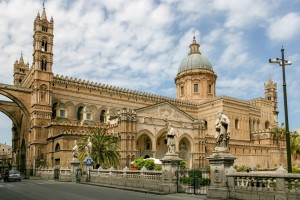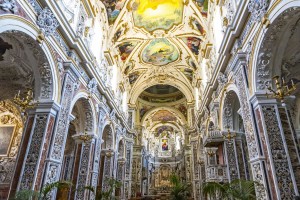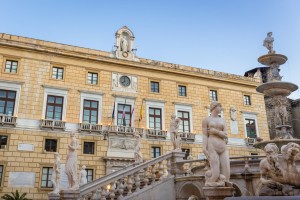
©Bigstock.com/magicbones
Italy’s fifth-largest city is located on Sicily. Palermo, the island’s capital, is one of the country most important places in more than one way. Not only is it Sicily’s political centre, its historical, cultural and architectural heritage holds its own against the largest, most popular cities of arts. Medieval Arab-Norman influences dominate the cityscape to this day. Countless churches and palaces, most of them arranged around central squares such as Piazza Pretoria and Quattro Canti, both surprise and impress due to their vastness, variety and uniqueness. The city of arts Palermo is one of those places where you can discover something new, almost magical, during every visit. We show you the must-sees for your next holiday. First off, however, let’s take a look at the city’s riveting history.
Palermo’s history between economic and cultural centre
The nearby Addaura cave suggests first human settlements in the region around 8000 BC. You can see corresponding finds in the city of arts’ Museo Archeologico. Palermo itself was founded by the Phoenicians in the 8th century BC as a trade hub. The city was likely called Ziz (“The Flower”), probably due to the fertile soil. Even though Palermo was never ruled by the Greek, they actually gave it its current name: Pánormos, the “wide haven”. The Romans conquered the city during the First Punic War and allowed it to thrive. The Vandal conquest and subsequent East Roman recapture initiated Palermo’s loss of significance. Muslim rule, however, became the catalyst for an unprecedented boom. You can still see traces of this era today. Named capital of the emirs on Sicily in 831, Palermo was Europe’s third-largest city for some time and a flourishing trade centre.
The Norman conquest in 1072 and subsequent Hohenstaufen regime resulted in the construction of several churches and palaces that are still among the most important sights of the city. Some buildings and structures were even declared UNESCO World Heritage Site in 2015. Charles of Anjou moved his kingdom’s capital to Naples. Palermo became more and more impoverished eventually leading to the bloody Sicilian Vespers. Frequently changing rulers set in motion a major loss of significance over the following centuries. Heavily affected by wartime bomb raids, Palermo saw a massive influx of new residents from rural areas leading to the construction of numerous poor buildings. Furthermore, the city was the site of violent Mafia wars. Mayor Leoluca Orlando’s mandate saw somewhat of a revitalisation of the public and cultural life in more recent years.
Palermo’s churches

©Bigstock.com/katatonia82
Norman rule in particular saw the construction of numerous churches in the city of arts Palermo. Listing them all would go beyond the scope of this article. Here are some houses of prayer you must visit:
- Cattedrale di Palermo: The largest and most important church of the city of arts, full name “Basilica Cattedrale Metropolitana Primaziale della Santa Vergine Maria Assunta”, dates back to the 6th After an earthquake the current Norman-Arab building was created between 1184 and 1185 and converted several times in later times, most notably by Ferdinando Fuga at the tail end of the 18th century. Ranging from the classic Norman fortified church structure to the Arab elements on the three apses to the late Gothic portico, the façade neatly shows off this architectural variety. Inside you get to experience Fuga’s conversions in all of their glory, accompanied by precious sculpting. There’s a sort of sundial along the astronomic meridian on the floor in front of the altar room. The sunlight coming in from the cupola crosses this line exactly at noon.
- San Giovanni dei Lebbrosi: Palermo’s oldest Norman-Arab church likely originated around 1071 outside the former city walls. It’s situated in a small park featuring three apses and hemispherical domes characteristic for Palermo’s Norman houses of prayer. The slightly ogival windows, however, are likely some of the first ogives of the Christian West.
- San Giovanni degli Eremiti: This building might have seen many an alteration, but it still carries its medieval gleam thanks to Giuseppe Patricolo’s baring and restoration in 1877. The characteristically Norman church with ogival window openings contains remains of old frescoes and murals shrouded in mystery.
- La Martorana: Many changes also happened to this originally central-plan building from the mid-12th Initially, a Benedictine convent was annexed. A baroque façade and a belfry with upper floors adapted to Catalan Gothic stylings were added later. Ostentatious, radiant mosaics – especially at the highest point of the church, the nave dome – will most certainly enchant you.
- San Cataldo: Find the former private church of Majone di Bari, admiral under King William I of Sicily, right next to La Martorana. The Apulian cube structure, very typical of its time, unveils tall, three-nave rooms with ancient pillars. San Cataldo is particularly popular for weddings.
- Chiesa di San Giovanni alla Guilla: The former seat of the Maltese Order became a repeatedly renewed church with Sicilian baroque revetments which sadly are poorly preserved. The upper floors with old Romanesque elements actually look the best today.
- La Magione: Also known as Santissima Trinità, this is one of Palermo’s final Norman-built churches. La Magione was renovated extensively after World War damages allowing you to marvel at the medieval wooden ceiling and the multi-layered cloisters.
- Santo Spirito: There used to be a Cistercian abbey outside Palermo. Adverse climatic conditions led to its abandonment and demolition leaving only the church Santo Spirito behind. Having had later baroque touches removed, it now oozes Norman charm.
- Sant’Agostino: As the name suggests, Sant’Agostino is an Augustinian church. The Gothic building dates back to the late 13th century, the richly adorned façade with rosette came a bit later. You will probably be surprised to find baroque stucco inside.
- San Francesco d’Assisi: First Franciscan settlements can be traced back to the year 1235. The current church was built between 1255 and 1277 yet had to be renovated in the style of Sant’Agostino due to severe war damage. Astonishing paintings grace the chapels of this Gothic building.
- Chiesa del Gesù: The oldest Jesuit church, however, is one of the newer sacred buildings of the city of arts Palermo. This house of prayer with a fairly plain façade was constructed during the second half of the 16th Works on the interior took until 1860 which shouldn’t surprise you when you see the ostentatious selection of paintings, frescoes and reliefs. The Jesuit house Casa Professa with Palermo’s public library is behind the church.
Fascinating palaces

©Bigstock.com
There aren’t just plenty of churches in Palermo, you’ll also find tons of palazzi. Located especially at and around central squares such as Quattro Canti and Piazza Pretoria (with the astonishing Mannerism fountain you absolutely shouldn’t miss out on!), they feature highlights such as:
- Palazzo dei Normanni: The Norman Palace or Palazzo Reale awaits you at the highest point of the medieval city. Its oldest walls even date back to Phoenician-Carthaginian times. The former seat of Norman kings might have lost three of its four towers over the years but received a Renaissance façade that wonderfully harmonises with the rest of the original structure. Glorious Renaissance arcades and 19th century mosaics accompany your palazzo tour.
- Palazzo Chiaramonte: Sicily’s 14th century late Gothic architectural style is also known as the “Chiaramonte style”, and that’s due to this palace. The cube shape and the almost windowless ground floor seem rather non-descript. However, the wooden ceiling in the main hall is must-see. Biblical, apocalyptic, mythological, erotic, and heroic epic scenes line the fascinating panelled ceiling.
- Palazzo Sclafani: It took Manfredi Chiaramonte decades to build his palace. His brother-in-law Matteo Sclafani wanted to humiliate him by constructing this palazzo in no time. Several restorations added Arab and Norman elements to the originally Gothic architecture.
- Palazzo Branciforte: This royal house turned pawnshop near the sea dates back to the late 16th A road divides the two parts of the building connected via corridors and bridges. Representative rooms richly decorated with frescoes line the ground floor. The palazzo currently houses numerous exhibitions and collections, including archaeological finds, majolica, coins, stamps, and sculptures.
Art and culture
Palermo’s cultural life saw a distinct upswing over the most recent decades. You can now find several museums, art galleries, and (reactivated) theatres and opera houses throughout the city that very much enrich the cultural life. We recommend the following:
- Museo Archeologico: From Sicily’s prehistory to the Late Roman time, the city’s archaeological museum is dedicated to finds from the western part of the island. Fascinating Greek bronzes and finds from Selinunte with parts of temples are among the highlights of this three-storey exhibition.
- Galleria Regionale: The two-storey late Gothic Palazzo Abatellis houses Palermo’s art gallery. It focuses on frescoes, paintings, sculptures and ceramics. Among the most exciting pieces are the “Annunziata di Palermo” by Antonello di Messina and the fresco “Triumph of Death” by an unknown master, both 15th century works.
- Museo Diocesano: Palermo’s sacral art found a fitting home in the episcopal palace Palazzo Arcivescovile. A round tour leads you through the rooms where the architecture itself – including old Gothic windows from the early construction stages – become art. Various halls are dedicated to Sicily’s schools of paintings, including those of Antonello Gagini, Vincenzo Gaggini, and Pietro Novelli.
- Museo Etnografico: If you’ve always been interested in Sicily’s culture and people, the island’s ethnographic museum is the perfect place for you. Handmade puppets from the popular Sicilian puppet theatre and the intricately painted Sicilian carts that used to be drawn by horses and donkeys up until the 1950s are among the most riveting exhibits.
- Teatro Massimo: We cap things off with a piece of Historicism. The former site of the San Giuliano church and abbey is now home to this astonishing theatre finished in 1897. The richly decorated hall can seat about 1,300 people. Furthermore, the final scenes of “The Godfather Part III” were shot inside Teatro Massimo.
Palermo is one of those cities where one day simply isn’t enough. Our list of sites merely scratches the surface of the Sicilian capital with splendour and variety, tons of beaches, and the gorgeous views of the gleaming sea and even many a mountain wowing you anew day in and day out. We recommend spending at least an extended weekend in the city of arts Palermo to explore and enjoy the numerous churches and palaces at your leisure. Palermo is always worth the journey – give it a shot!